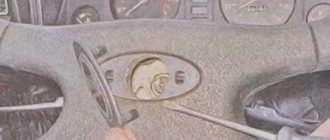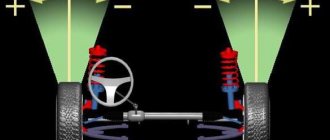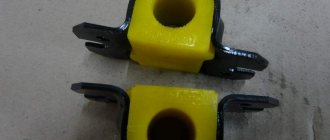Background[edit | edit code]
In the mid-1950s, NAMI developed a promising type of minicars and their units, planned for development during the implementation of the Seven-Year Plan for the Development of the National Economy (1959-1965). This type included three types of cars: a four-seater general-purpose microcar intended for sale for individual use (the future ZAZ-965); a two-seater microcar for disabled people, designed to replace wheelchairs from the Serpukhov plant (the experienced NAMI-031, did not go into production) and a light multi-purpose cargo-passenger vehicle, designed to transport four people, or two people and 200–250 kg of cargo.
The development of the latter concept was started by NAMI in 1958 together with the Irbit Motorcycle Plant with the construction of a prototype NAMI-049 “Ogonyok”, the design of which was largely based on the previously developed military amphibious all-terrain vehicle NAMI-032G (late 1956 or early 1957). The car had a steel supporting base and body frame (pillars, windshield frame, tailgate opening), onto which fiberglass outer panels (tails, doors, hood, side) were attached. As a result, an optimal combination of weight was achieved - only 752 kg in running order - and dynamic qualities - the maximum speed with a 22-horsepower Irbit MD-65 engine was 80 km/h, as well as fuel consumption - 6.7–7.1 l/ 100 km, depending on road conditions. Independent torsion bar suspensions on trailing arms, permanent drive to the front axle with the rear axle being disengaged, lockable wheel differentials, and wheel gearboxes were used. The carrying capacity was 300 kg with two passengers, or four passengers.
Subsequently, the designers of a repurposed for the production of minicompact cars (Zaporozhye, Ukrainian SSR) joined the work on the car, on which prototypes of the NAMI-049A “Tselina” (light truck) and ZAZ-969 were created, unified in the power unit with the ZAZ model that had just been mastered by the plant -965 “Zaporozhets”.
Origins and photos of LuAZ 969
Changes began when the TPK (front line conveyor) concept was developed specifically for the Airborne Forces at the Research Automobile and Motor Vehicle Institute. It was an ordinary motorized cart that was parachuted from an airplane and, in addition to the driver, carried several stretchers or six wounded people in a sitting position. Mandatory requirements were a low silhouette, all-wheel drive and a winch. In addition, the TPK was an amphibian, that is, it swam by rotating its wheels. The prototype was named “Ogonyok” with the index NAMI-049. In addition to all-wheel drive, it was equipped with an independent torsion bar suspension, center and two cross-wheel locking differentials and gearboxes. The conveyor was driven by a 22-horsepower engine, so it was decided to further develop this project.
NAMI-049A was already equipped with a steel body with an awning (the previous model had a body made of fiberglass). The chassis has undergone some changes: the center differential has been removed, and the rear axle has been made switchable, making it possible to drive on asphalt roads. More important than anything else was the installation of a new 27-horsepower 0.9-liter engine, the same one that was later installed on the famous “humpbacked” Cossack.
Watch the story about unknown Soviet SUVs that remained models.
Car subframe: why is it needed and how to make a subframe for Niva 2121? More details here.
In this form, the TPK began to be produced in Lutsk as the LuAZ 967. Until 1989, these cars were produced in large quantities, having undergone several modernizations and, as they say now, redesigns. In 1969, LuAZ finally reached the military, where it was used as part of motorized rifle and airborne units.
LuAZ also proved itself outside the USSR in other Warsaw Pact countries. The amphibious transporter, according to some experts, has no analogues to this day. Over time, the LuAZ no longer became a cart and a light jeep, and in some modifications it even acquired its own weapons.
The civilian version of the transporter has undergone a number of design changes, the main one of which is the abandonment of buoyancy. Adapting the car for the needs of villagers, the design engineers changed the seating position of the driver and passengers, added fastening canvas sidewalls, and gave some semblance of shape to the body contours. The modified conveyor under the index 969 was produced in the first thirty units in Zaporozhye, after which production was transferred to the same Lutsk Automobile Plant.
Modernization
The first Bagpipe models, despite the use of advanced technologies, had many shortcomings. Therefore, the Lutsk Automobile Plant soon raised the question of modernizing the SUV. This is how the first modification of the LuAZ-969M was born.
First of all, the designers sought to increase engine power. But the chassis was not left without attention. The body and interior have been significantly improved. The design of the car also changed a little - for the first time on the Bagpipe, full-fledged windows appeared on the side, and the seats began to be equipped with seat belts. Attention was also paid to the issue of sound insulation. The solution to this problem was the installation of appropriate panels.
The modernized car did not lose its position and was actively sold in the domestic market. And even now there are a lot of advertisements for the sale of this miracle of the Soviet automobile industry.
First in everything!
LuAZ-969M is the first light SUV in the history of the Soviet automobile industry, which featured both all-wheel drive and front-wheel drive. It was intended for the needs of agriculture and became a truly popular car.
We should pay tribute to our Soviet engineers who created this creation. The technical equipment of LuAZ at that time was the most modern, and in general the 969th model was distinguished by the use of a number of advanced technologies. Thus, each wheel had its own gearbox installed separately, due to which the vehicle’s ground clearance was significantly increased. Also, the cross-country ability was significantly influenced by the design of the drive shaft, which was enclosed in a pipe. The suspension of the Lutsk SUV was independent (both front and rear). And the car itself was distinguished by a surprisingly light curb weight. This was facilitated by the new semi-supporting body structure, as well as the minimum amount of technical equipment used on the SUV.
Appearance
Despite its small size, the body consists of an integrated spar-type frame. Volyn is equipped with a tent top, which allows it to be universal. Small doors hang on hinges, thereby simplifying installation and dismantling.
The 969th model also differs from other cars in that the windshield wipers are attached to the top, and not, like other cars, to the bottom, which is a positive thing when driving in bad weather.
If in the previous model the arcs were needed only for attaching the awning, then in the “M” version they come already in a strengthened state. They protected the interior when the car rolled over. When updating the LuAZ-969M, it received new lighting equipment. Locks were installed on the doors, and seat belts appeared.
One of the most serious drawbacks of the bagpipe body was its susceptibility to corrosion. But this disadvantage can be easily solved with a simple brush. The awning does not have any particularly negative aspects, however, those who like to travel along forest roads should install a hard metal roof.
Then it will no longer be scary that branches can tear the roof. With the arrival of the update, the appearance of the vehicle was changed. For the first time, Bagpipe began to have full-fledged windows.
In addition, special attention was paid to sound insulation. They installed a windshield with a different shape, and the doors already had locks (that’s what you thought, they had never installed locks before!).
The front body became less angular, and the car began to look different. It's not so easy to believe, but a small car, from a small city in the big Soviet Union, was able to achieve international recognition.
And these are not just words, for example, even before serial production, in 1978, at the International Motor Show in Turin, the 969th model entered the top 10 best off-road cars in Europe!
It is clear that the automotive market for off-road models was previously a little different, but this does not change the essence of the matter.
Transformation and care
Success among the masses (or simply the lack of an alternative from front-wheel drive cars) allowed LuAZ to enter the international market and transform itself. In 1975, a 4-horsepower Zaporozhye engine was installed on the model, the interior and body were slightly changed, the lighting equipment was replaced, locks were finally added to the doors, and four years later they were launched into production under the LuAZ 989M “Volyn” index. It even got to the point that the updated car in 1978 at the Turin Motor Show was recognized as one of the 10 best European SUVs.
In 1985, the indices changed and the 989M became known as LuAZ-1302. However, not only the name changed: the main change was the 53-horsepower 4-cylinder engine from Tavria, which was not only economical, but also gave at least some dynamics. If the 989M, when driving at 60 km/h, consumed 10 liters per hundred, then the 1302 consumed only 7.7 liters, and the maximum speed increased from 85 to 100 km/h. LuAZ 1302 borrowed seats from the VAZ 2108, received additional noise, and as a result became faster and more comfortable. However, by the time of release, Ukraine had already become an independent state, so the Russians were unable to evaluate the new product.
Together with the USSR, the golden times of “Volyn” also ended. The Ukrainian period of history was not entirely successful: the production of small batches under government orders, unsuccessful modifications and special versions showed that Volyn had already missed its best years, having failed to establish full-fledged in-house production.
Ignition system features
Since the civilian version of the car could not swim, the ignition systems were designed according to the classical scheme:
- Battery-coil design with one spark plug per cylinder;
- The battery is standard 6ST-55;
- Alternating current generator G-501 (or G-502 on modifications);
- Rectifier unit BVG-2A;
- Blocking relay;
- Fuses (6 pcs).
LuAZ 969 instrument panel with fuses.
Also on the instrument panel there are 2 thermometallic fuses with a nominal value of 20A for protection:
- Heater electrical circuit;
- Lighting of the body and engine compartment;
- Plug sockets;
- Sound signal;
- Brake alarm systems (see also wiring diagram Niva 21213).
https://youtube.com/watch?v=tkANFBOcU8w
A bimetallic fuse is also used to protect the windshield washer and wiper circuit. It is installed under the hood and has a response threshold of 3.5A.
People's love
“Volyn” became famous among the people. She is both loved and hated, but she is clearly not treated with indifference. You can even judge this by the car’s nicknames: the already mentioned “zhuzhik”, “Bagpipes”, “Luntik/Lunokhod”, “jerboa”, “Cheburashka”, etc.
The first popular “rogue” is a great seller to this day, and the reason is not only its outstanding off-road qualities. The almost complete lack of comfort opens up scope for tuning the LuAZ 969, which attracts craftsmen.
You can buy a LuAZ 969 today in several ways:
- from private hands. The price is individual, depending on mileage and condition. There are cases when they sell completely new cars, with a mileage of a couple of kilometers and in perfect condition, the car has just been in the garage for 20-25 years. Collectors are willing to pay a lot of money, which sellers naturally know.
— buy a LuAZ 969 from conservation. Mothballed LuAZs are cars written off from reserve in military units and sold to private individuals. Please note that this way you can only buy early versions, and the condition of the cars can be either close to ideal or practically ruined. In addition, it is necessary to properly depreserve the car and prepare it for use.
LuAZ-969M "Volyn" photos
photo of LuAZ-969 “Volyn”
photo of LuAZ-969 “Volyn”
photo of LuAZ-969M “Volyn”
photo engine LuAZ-969M “Volyn”
photo of LuAZ-969M “Volyn”
photo of LuAZ-969M “Volyn” on tracks
Reworking the LuAZ steering rack
An analogue from Volkswagen can be used as this unit. Before installing the rail, spacers are installed under the front beam with a height of 4 centimeters, which are shifted forward by 50 mm. This is necessary in order to be able to use R15 size wheels.
The steering rack on the LuAZ 969M, the modification of which is carried out by replacing it with an analogue of the Volkswagen Golf 2, is welded to the front suspension beam. This operation is carried out through a bracket made of a 40*60 mm square profile and a corner. A three-millimeter bracket is welded directly to the frame, which serves as a mount for the bevel gear. On the reverse side, a similar element is bolted to the body. After finishing the work, all that remains is to remove the play in the rear beam. As a result, the steering wheel turns easily, there are no gaps or rattling.
Design[edit | edit code]
The body of the LuAZ-969 car is semi-supporting, with an integrated spar-type frame. The layout of the car is characterized by a strong displacement of the passenger compartment forward, which made it possible to achieve a constant high load on the front axle, thereby ensuring high traction and grip properties even when driving only the front wheels.
The engine is a V-shaped, four-cylinder, very close to the engines of small cars of the Zaporozhets brand. Until 1975, LuAZ was equipped with a MeMZ-969 engine with a displacement of 877 cm³ and a power of 30 hp. With. (analogous to Zaporozhets engines models 965A and 966B), after - MeMZ-969A, 1197 cm³ and 40 hp. With. (analogue 968). Regardless of the version, the engines were equipped with a cooling system with a forcing (and not an exhaust, as in early Zaporozhets models) fan, which took air through a grille in the front end lining and drove it through the cooling jackets of the engine heads and cylinder block, while the direction of the flow The air was set by a system of sheet metal casings installed on the engine (much less developed, however, than on later Zaporozhets models). In addition, the lubricating oil circulating in the engine was cooled in the oil cooler and in the engine crankcase, the pan of which had a ribbed surface that facilitated heat dissipation. Unlike the Zaporozhets, there were no thermostats in the engine cooling system; the engine temperature during warm-up and in winter conditions was maintained manually by the driver due to the blinds installed between the front end lining and the fan, driven by a handle on the instrument panel (which was much more reliable than automatic adjustment of air flows on "Zaporozhets"). Made as a separate unit, the interior heater could be used in winter to preheat the engine.
Transmission diagram for LuAZ vehicles (all-wheel drive version).
The LuAZ transmission as a whole is characterized by a comparative simplicity of the device by the standards of SUVs (double-shaft gearbox, absence of cardan shafts and transfer case), which has a positive effect on the weight-dimensional characteristics and reliability. The main gear and twin-shaft gearbox are located in the front of the car and are combined into a single unit (transexl), partly similar to that used on Zaporozhets cars (the crankcase, except for the rear cover, and many other parts are unified with the gearbox of 1.2-liter 40-horsepower models "Zaporozhtsev"). Gear shifting is carried out by a floor lever located on the rear cover of the gearbox housing, and the shift layout differs from the traditional one (“mirror”): the first gear is engaged by moving the lever from neutral towards you and back, the second - towards you and forward, the third - from neutral back , fourth - from neutral forward, reverse - from neutral away from you and forward. A power take-off mechanism from the secondary shaft, used either to drive various agricultural equipment, or (on all-wheel drive versions) to drive the rear axle, and (also on all-wheel drive versions) a reduction gear is also mounted inside the gearbox housing cover.
From the very beginning, the gearbox of LuAZ cars had a fully synchronized series of forward gears and a hydraulic clutch (its external feature is a technological connector in the middle of the main gear housing) - unlike the Zaporozhets, whose versions with engines with a working volume of 750 and 877 cm³ were equipped with a different architecture (“Fiat”) gearbox with unsynchronized first gear and cable-operated clutch (with a technological connector between the clutch bell and the gearbox housing itself). The LuAZ variants with the 877 cc MeMZ-969 engine differed from the later 1.2-liter ones only in a different clutch bell (made together with the front half of the final drive housing). The gearbox for the Zaporozhets with a 1.2-liter engine was designed on the basis of the LuAZ transmission by eliminating the power take-off mechanism with reduction gear from its design, installing a pair of fourth gear gears with a higher gear ratio and developing a new gear shift mechanism designed for remote traction drive.
For all-wheel drive modifications, rotation is transmitted from the power take-off shaft of the gearbox to the rear axle gearbox using a thin shaft without hinges, enclosed inside the transmission pipe connecting the gearbox and rear axle housings. Thus, all the vehicle’s transmission units, except for the axle shafts, are essentially enclosed in a common sealed crankcase, which is a legacy of LuAZ’s amphibious past. The rear axle is disabled in the normal state of the transmission; it can be connected from the driver’s seat, for which it is necessary to move the lever located to the left of the gearshift lever to the rear position (with the lever in the forward position, the rear axle is correspondingly disabled). There is no center differential, so when driving on paved roads, the rear axle must be disengaged, and the car becomes front-wheel drive. The same lever also controls the inclusion of a downshift - to engage it in the connected rear axle mode, you must move the rear axle connecting lever away from you and move it forward, while the gearbox lever must be in the neutral position.
To prevent one of the rear wheels from slipping, the rear axle differential can be forcibly locked from the driver's seat by a curved lever located next to the parking brake lever. The locking mechanism is with a gear coupling. There is no front axle differential lock.
The suspension is torsion bar, on trailing arms, with large strokes. The wheels are 13-inch, with a developed mud tread pattern. The wheel pattern corresponds to that used on rear-wheel drive Moskvich cars, but the wheels themselves are original, with a large positive offset, and, unlike other AvtoZAZ products, they have a disk design.
Brakes are drum brakes on all wheels, hydraulically driven, without power assistance.
Installing a VAZ engine on a LuAZ
But what features will a car owner encounter? What problems are fraught with installing a VAZ engine on a LuAZ? But everything has been studied for a long time, so you are unlikely to become a discoverer. But using other people’s experience is simply necessary.
The ZAZ “magpie” is a V-shaped “air vent”, and the VAZ engine is a liquid “four”. In addition to the increased mass, the main problem will have to be solved - size. The engine compartment of the LuAZ is much smaller, so simply “remove and install” will not work here. The radiator simply won't fit. Therefore, you will have to choose - either lengthen the “face” of the LuAZ when installing the VAZ engine on the LuAZ, or two small radiators from the Oka (VAZ-1111) on the sides of the cylinder block. The first one is simpler and cheaper (the radiator from VAZ is cheaper, and it’s easier to buy), but the factory appearance is ruined. The second one is more expensive, but there are no external modifications. Which one to choose is up to you, most likely, everything will depend on the availability of spare parts.
The second problem when replacing the installation of a VAZ engine with a LuAZ is the adapter plate. It’s no secret that the fastenings of the VAZ and ZAZ blocks are different, so you can’t do without a specially cut element. But it’s not at all difficult to do. There are two options. Either a print “on the spot”, or a drawing of the finished product, most often from the Internet. Then a piece of metal, a familiar turner-milling machine, bolts for fastening and voila - the engine and gearbox became one. You can put it in place.
Third is the steering. So the engine itself will have to be placed a little higher than desired. But don’t push it too hard so that the air filter gets stuck. So you will have to find a “golden mean” - the eternal headache of installers.
And the last thing is a slightly different engine compartment layout. But this can all be solved, and quite simply. Self-made fasteners, think a little about how to install everything and you're done. As a last resort, you can always redo it. LuAZ is a car for those with good hands.
Of course, you can try to find a LuAZ 1302 with an engine from Tavria. But then it won’t be interesting, and the quality of the latest cars leaves much to be desired.
More on the topic
Modernization[edit | edit code]
LuAZ-969A[edit | edit code]
In 1975, the LuAZ-969A
with an improved MeMZ-969A[1] engine (1.2 l, 40 hp). This was the first Lutsk car to bear the LuAZ brand. It could be distinguished from ZAZ-969V and ZAZ-969 by the presence of a window in the awning. About 30.5 thousand cars of this model were produced.
In 1977, a batch of closed all-metal vans was also produced. In E. Thompson's work on Soviet cars it is designated as LuAZ-969F.
LuAZ-969M[edit | edit code]
| LuAZ-969M "Volyn" | |
| Manufacturer | LuAZ |
| Years of production | 1979—1996 |
| Body type | 3-door phaeton (2 (4) seats) - station wagon |
| Platform | LuAZ-969 |
| Type | carburetor |
| Volume | 1198 cm3 |
| Maximum power | 40 l. s., at 4100−4300 rpm |
| Configuration | V4 |
| Cylinders | 4 |
| Valves | 8 |
| Max. speed | 120 |
| Cylinder diameter | 76 mm |
| Piston stroke | 66 mm |
| Compression ratio | 7,2 |
| Supply system | Carburetor |
| Cylinder operating order | 1-3-4-2 |
LuAZ-969M
(in development since 1973) was introduced in November 1977[2], mass production was launched in 1979, it was distinguished by an increased mileage to 100,000 km before the first major overhaul, updated components (a more powerful 6TST-50EMS battery, new headlights) [1], as well as the shape, design and finish of the body. A noticeable difference in appearance is the modified front part.
- LuAZ-969M
- Back view
- LuAZ-969M
- Driver's workplace
This model was equipped, like its predecessor, with a 1.2-liter 40-horsepower MeMZ-969A engine, but was equipped with a separate brake drive with a hydraulic vacuum booster on the front circuit. The exterior of the car has been modernized: the front panels and the shape of the windshield have changed. The doors were equipped with locks, their side windows received a rigid frame and opening “windows”, a soft instrument panel, a safety steering column and “Zhiguli” seats appeared in the cabin.
Even before the launch of the series, the LuAZ-969M was highly praised at the Exhibition of Economic Achievements of the USSR, and in 1978, at the international salon in Turin (Italy), it (as indicated in a number of sources) entered the top ten best cars in Europe. In 1979, at an international exhibition in the city of Ceske Budejovice (Czechoslovakia), he received a gold medal as one of the best cars for village residents.
LuAZ-2403 was created on the basis of this vehicle.
.
LuAZ-1302[edit | edit code]
Maximum lateral stability angle - 40 degrees; Fording depth - 0.5 m; Wheels:
- wheels - 4.5J/13;
- tires - 175/80R13.
In 1991, small-scale production of LuAZ-1302
. The key difference between this modification is the MeMZ-245-201K generation engine, intended for Tavria and LuAZ-1301[3] (1.1 l, 53 hp, liquid cooling).
External differences from the “969M” consisted of the appearance of a thick spacer between the front panel and the front wings, as well as the transfer of the side lamp from the sidelight to the headlight. The car had reinforced side members, a new instrument panel, additional noise and vibration insulation and more comfortable seats from Tavria (in the production part, old Zhiguli seats were installed). Fuel consumption and noise have decreased significantly, dynamics have improved.
On May 9, 2002, the plant decided to stop production of LuAZ-1302 (instead of which it was planned to master the production of LuAZ-1301M)[4].
Modifications
As you know, the TPK, which gave birth to our model, had several modifications, for example, three-axle cars. It is clear that “Volyn” itself has a considerable number of variations. Interestingly, the vast majority were already produced in post-Soviet times on the platform of the 1302 machine.
At one time, the enterprise tried to integrate into the laws of a market economy and manage to fulfill government orders. There is information about models that have a body, an extended wheelbase, a hard top, an extended rear overhang and four doors.
There was also a special version of “Foros”, which had a “jeeper” appearance and the original 6-wheeled floating “Geologist”. These transport models of the “birthmark” of the front line army vehicle could pass without difficulties in those places where the more massive models of GAZ, UAZ and Niva simply “gave up”.
Unit 969
- LuAZ-969V - the model was produced from 1967 to 1971 and was a temporary version with front-wheel drive.
- LuAZ-969 - the car was produced from 1971 to 1975. It was a serial variation and had a 4x4 wheel arrangement.
- LuAZ-969A - produced from 1975 to 1979. The car represented the first modernization with the MeMZ-969A power unit.
- LuAZ-969M is a car of the second modernization, produced from 1979 to 1992. The model came with an updated body.
Modifications[edit | edit code]
Family "969"[edit | edit code]
- ZAZ-969V
/
LuAZ-969V
/
LuMZ-969V
(1966 or 1967—1971 or 1972) - temporary version, front-wheel drive; - ZAZ-969
/
LuAZ-969
(1971-1975) - serial with a 4x4 wheel arrangement; - LuAZ-969A
(1975-1979) - first modernization, MeMZ-969A engine; - LuAZ-969M
(1979-1996) - second modernization, updated body;
Family "1301" (experimental)[edit | edit code]
The project to update the LuAZ SUV model range is not to be confused with the next LuAZ-1301 platform.
- LuAZ-1301
(experimental car of 1984) - is a platform (chassis and engine) of LuAZ-969 (the “969M” modification was taken as the basis) with a new body. Later the engine was replaced with a motor from Tavria.
Family "1302"[edit | edit code]
Options with liquid-cooled engines, mainly MeMZ-245. Production ended May 9, 2002[5]
- LuAZ-13021
(prototype) - a cargo modification of the LuAZ-969M with a base extended by 200 mm and a cargo platform[6]. Subsequently, the type of onboard body was changed, and the base for the production model became 1302; - LuAZ-13021
is a serial flatbed truck with a carrying capacity of 400 kg[7]. Some options were equipped with a gearbox from Moskvich-2141 without drive to the rear axle; - LuAZ-13021-03
- modification of model 13021 with a normal rigid cabin and a sunroof; - LuAZ-13021-04
is a long-wheelbase cargo-passenger modification of model 1302, created for mobile repair teams to maintain power lines and pipelines. There are four seats in the double cab; up to 250 kg of cargo can be transported on a shortened cargo platform[8]; - LuAZ-1302-05 “Foros”
(1998) - a commercial modification of the LuAZ-1302 with a 37-horsepower Italian diesel engine “Lombardini” LDW-1404 and an open body with roll bars[9]. - LuAZ-13021-07
- a variant of model 13021-04 with an extended van-type body with a fiberglass top and a metal tailgate[8] - LuAZ-13021-08
is a modification of model 13021-07 for the Ambulance service. The top is made of fiberglass. To conveniently accommodate stretchers, the rear part of the body has been lengthened by more than 600 mm, resulting in an increased rear overhang. The body has four doors: one on the left, two on the right and a rear one[8]
Final work on tuning the standard engine
When remaking a LuAZ in the engine part, you don’t need to be particularly zealous when grinding the heads. Practice shows that grinding over 2.5 mm leads to the breaking of the studs. The standard compression ratio is 7.4, and after turning it increases to 9. Exceeding this indicator leads to deformation of the power plant and burnout of the pistons.
After grinding work, it is necessary to use AI-92 fuel, having previously replaced the piston rings with more durable modifications. After the process is completed, the operating temperature will increase, and therefore it is necessary to worry about the forced cooling system.
Some craftsmen manage to bore the cylinders for a 79 mm piston, which makes it possible to increase power to 60 “horses”. It is recommended to split the exhaust assembly into two pipes, which will make it possible to more accurately adjust the operation of the power unit by improving the ventilation of the cylinders. At this point, the modification of the standard LuAZ engine can be considered complete.
Reliability and safety
If we talk about the durability and reliability of this vehicle, then there are many conflicting opinions among drivers. A clear advantage is the Zaporozhye power system itself, which is included with the machine.
It is located in front, which avoids difficulties with its overheating. However, it also has its own rather significant drawback - low engine life.
Speaking about the devices themselves that ensure the safety of the driver and passengers of the car, this model simply does not have them. You won’t find seat belts or airbags here, which are simply “stuffed” with cars of the latest generations.
Such decisions can be explained quite easily - in those years when the car was being designed, no one thought much about it. Therefore, when driving such an off-road vehicle, you will be able to get unique sensations that cannot be found on modern jeeps.
Prices and options
Since the vehicle was discontinued from serial production a long time ago, it is only possible to buy it second-hand. To ensure that the choice is not wrong, you need to carefully find a car and review a whole stack of advertisements.
It often happens that the car has been subject to corrosion, and it is very unpleasant when the rust eats away the bottom. Generally speaking, the Bagpipe has always had such a drawback, so after the purchase, car owners often have no choice but to weld the body in a new way.
Although, if you look at its cost from a different perspective, which ranges from $200 to $1,000, the compact Soviet SUV can be forgiven, if not everything, then a lot. It’s interesting that you can find advertisements online where Lutsk cars are for sale from $3,000 to $5,000.
It is clear that based on such a cost, the technical condition of these machines is as if they had recently rolled off the assembly line, or they had been tuned. Although the easiest way is to buy a model for $200 and then “upgrade” it with your own efforts, provided that you have free time.
LuAZ-1302
Lunokhod-1
Probably, the children from the surrounding dachas were most happy about Kirill's purchase, who decided that the LuAZ was not a normal, adult car, but a large mechanical toy that was very fun to ride on. Among children, the “Luazik” was known as the “Lunokhod” (by the way, this is what many adults also call this car - apparently, it evokes the appearance). And the first trips through the fields pleased the despondent owner. The cross-country ability of the Lunokhod turned out to be brutal - even despite the ridiculous standard 13-inch wheels.
It was to these that Kirill and his friend Anton went to their first off-road competitions - curiosity led them. The impressions remained chaotic. I remember other trophists kept asking when normal wheels would be delivered to them. And they had difficulty returning their eyes to their place and raising their jaws when they saw that the guys started the way they arrived. Naturally, we sat down immediately. The boards, jack and ax taken from the dacha went irretrievably into the swamp. And if it weren’t for the famous jeep fraternity, the Lunokhod would still be sitting in that swamp. Even before the guys were rescued, they realized that they needed to seriously prepare for the next competition (and there was never any doubt that there would be a next one...
Advantages and disadvantages
Pros of the car
- Good off-road performance;
- Spacious interior;
- Low cost of repaired parts;
- Low cost of the machine;
- Small dimensions of the car;
- You can upgrade it yourself;
- Ease of Management;
- Inexpensive to repair;
- Acceptable ride height;
- Good maintainability;
- Canvas top;
- Not a bad gearbox.
Cons of the car
- Not reliable and not long-lasting LuAZ engine;
- Low sound insulation;
- Hard chairs;
- Low maximum speed;
- Lack of security devices and systems;
- The presence of a canvas top;
- High tendency of body metal to corrosion;
- It is not easy to find the necessary parts for a car;
- Hot in summer, cold in winter;
- Small wheels;
- Weak engine;
- Meager interior;
- Noisiness;
- There is no water cooling of the power unit.
Let's sum it up
Remaking the LuAZ will improve the characteristics and give a second life to the car in question. VAZ is one of the most popular donors in terms of power unit. By tuning the suspension and other main components, you will get a pretty tolerable light SUV. Modernization of the interior and exterior will add external aggressiveness and internal comfort. Considering that the costs of modernization are not so cosmic, if you have an old car of this brand, do not rush to scrap it. Restoration will help you get a real working rarity.
Source











